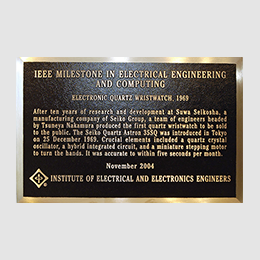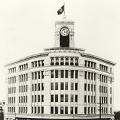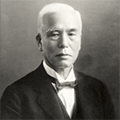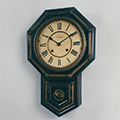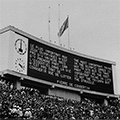Three domestic watches made by Seiko were officially designated as Mechanical Engineering Heritages in 2014
On August 7, 2014 (Day of Mechanical Engineering), the Japan Society of Mechanical Engineers designated three Seiko-made watches as Mechanical Engineering Heritages.
Three watches from Seiko were designated as Mechanical Engineering Heritages: Japan's first wristwatch, the Laurel (1913), the world's highest- quality mechanical wristwatch, the Grand Seiko, First Model (1960), and the world's first quartz wristwatch, the Quartz Astron (1969). All three were landmarks in the history of the development of domestic wristwatches and the technical development of watches globally. All three defined their periods and led to the quartz innovation of the world's watch industry. Shortly before in the Meiji Era, Japan had lagged far behind the advanced countries of the West in many industries. It caught up with the West in watchmaking and took the lead in only decades.
※About the Mechanical Engineering Heritages
A project established to memorialize the 110th anniversary of the Japan Society of Mechanical Engineers in 2007.
This project aims to preserve mechanical technology assets and pass them on to later generations as heritages.
1. Assets that brought about important results in the “development” of mechanical technology.
2. Assets that contributed to “living, culture, economy, and sociotechnical education” in the field of mechanical technology.
Introduction
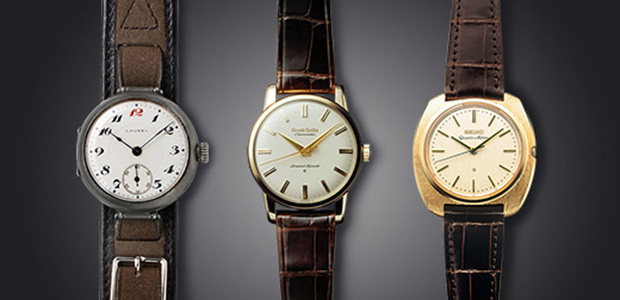
The oldest existing wristwatch was made by hand in 1806 for Josephine Bonaparte, the wife of Napoleon. The first wristwatches designed for mass production techniques were made in 1879 for the German Navy. According to records, Girard-Perregaux received an order for 2,000 watches to be used to measure the timing of bombardment.
The immediate forerunner of the wristwatch boom was the Santos released by Cartier in 1911. The Santos stoked enthusiasm for wristwatches around the world by dint of its elegant design and fervid popularity. The outbreak of the First World War in 1914 was a chance to promote the actual spread of wristwatches. Since then wristwatches have steadily evolved in terms of accuracy, practical functions, and mass production techniques.
The Laurel (1913), the Grand Seiko, First Model (1960), and the Quartz Astron (1969) were designated as Mechanical Engineering Heritages for their decisive roles in the history of the technical development of the world's wristwatches. In brief, Seiko forged a new history for the wristwatch by learning techniques from the world to make the Laurel, elevating the state-of-the-art in watch technology with the Grand Seiko, First Model, and revolutionizing the global wristwatch market with the Quartz Astron.
Mechanical Wristwatch Techniques
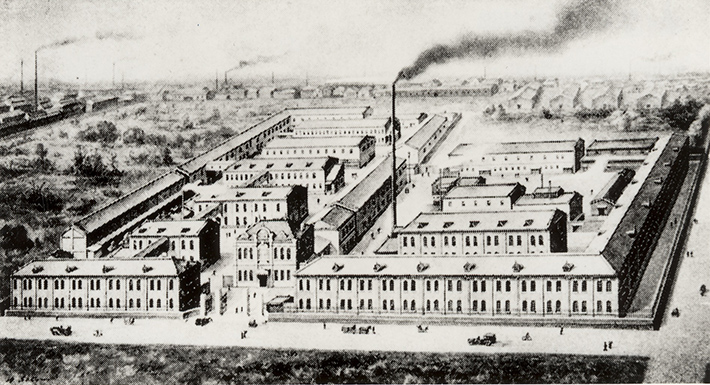
In 1872 Japan changed its time system from the seasonal time system to the fixed time system. This marked a big turning point in the timepiece industry.
Traditional Japanese clocks, which had been made for nearly 300 years, were suddenly useless. When Japan finally opened, it had no choice but to rely on imported timepieces from overseas to satisfy its growing demand for timepieces. Seiko (the former Hattori Tokeiten) started selling imported timepieces in 1881, established Seikosha 11 years later in 1892, and commenced the manufacture of wall clocks. Seiko produced a pocket watch three years later, in 1895, but only with great effort using designs modeled after leading countries in watchmaking such as Switzerland and the USA. Domestic makers of the time lacked the techniques and knowhow to develop watches by themselves.
-
STORY 01
Development of the Laurel, Japan's First Watch (1913) ~Learning from the World~
-
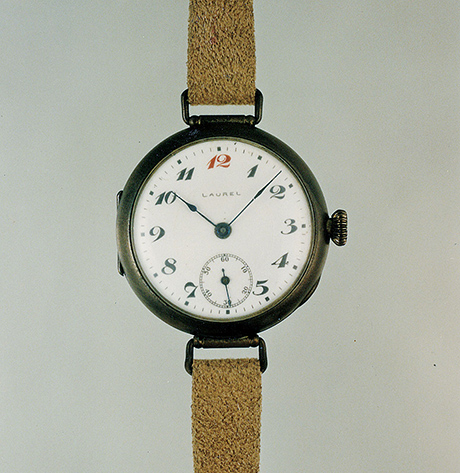
Laurel As mentioned in the introduction, wristwatches were obscure and largely unnoticed by the global public until 1911. The development of the Laurel in 1913 was an adventurous and challenging project for a Japanese manufacturer that was behind even in the domestic watch industry. Pocket watches were far more popular at the time, but Seiko founder Kintaro Hattori foresaw that wristwatches would prevail in the future. He set out to develop wristwatches domestically as soon as he could.
The development of the Laurel was a project of “Vision” and “Ambitious Goals” that stimulated the domestic watch industry and raised the level of the watch industry all over the world. The Laurel was a key step on Japan’s path to eventual leadership in the global watch industry.
The movement of the Laurel is thought to have been based on a structure made in Switzerland. Downsizing to the “12 ligne” size (φ26.65mm) was tremendously difficult with the technologies and production equipment available in those days. The project accelerated the advancement of design and microfabrication techniques and the development of machine tools.
-
STORY 02
Development of the Marvel (1956) ~Coming Up with the World~
-
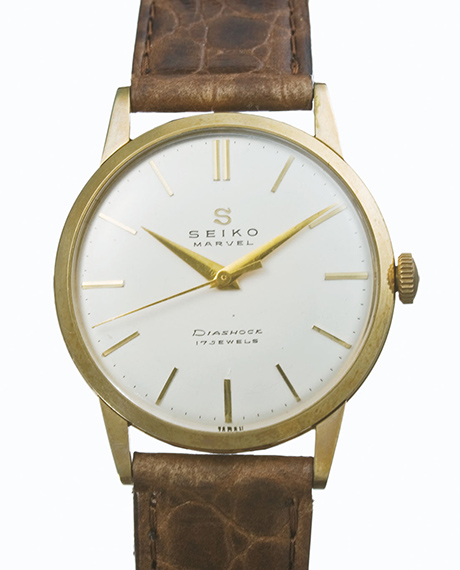
Marvel The Seiko wristwatches produced before the Marvel adopted the mechanisms of overseas watches. When the Marvel finally arrived with its unique and outstanding design devised at home, Seiko was launched on a path of rapid growth. By achieving a level of quality equal to that of a Swiss watchmaker, Seiko came to trust its own ability to compete with the Swiss and do what it believed was right. Seiko’s drive to innovate grew all the stronger.
The Marvel’s unique design returned to the rule and principle of the timepiece. Accuracy was improved by enlarging the movement (11-1/2 ligne) through the following adjustments: (1) scaling up the balance and barrel to stabilize the pace and achieve high-power performance, (2) scaling up the gear and increasing the number of teeth to reduce the unevenness of torque transmission, and (3) widening the center distance between the fastening members to prevent passing errors of the gear-supporting shaft (mortise) by thread fastening. The timepiece was also manufactured with production and machining technologies such as press precision drilling and a structure easy to disassemble and assemble.
The Marvel swept away rival timepieces in a domestic competition (Council for Quality Inspection of the Japan-made Watch: hosted by the former Ministry of International Trade and Industry). It also overtook overseas wristwatches by rivals such as OMEGA and won first place in the men's wristwatch category in a watch competition hosted by the American Watchmakers-Clockmakers Institute (Japanese branch).
The development of the Marvel, a timepiece designed in new manufacturing facilities based on a new concept and design policy, was a breakthrough for a domestic maker. Aficionados acclaimed it as an “amazing wristwatch” and personified it as “a guy with intelligence and health.” At last, domestic wristwatches were shedding their reputation for breaking down and keeping poor time.
-
STORY 03
Grand Seiko (First Model: 1960) ~Get Ahead of the World~
-
In 1959, Seiko developed the higher accuracy Crown by enlarging the movement (12-1/2 ligne) based on the Marvel.
1. The inertia efficiency was increased by 46 % with an enlarged balance.
2. An involute gear was adopted for the first time in a domestic wristwatch (greatly reducing the unevenness of the gear transmission)
3. Anti-shock device “Diashock”
4. Main spring without lubrication works
5. Oil-retention device “Diafix”
With help from the above mechanisms, the new Crown attained high accuracy, high quality, and excellence exceeding that of the Marvel in a wristwatch competition.
The Grand Seiko, First Model was produced based on the Crown by embodying the best possible techniques for parts accuracy, assembly, and accuracy adjustment.
1. Rigorous inspection to detect 1/1000-mm-errors in accuracy for the main plate and tooth profile
2. A hairspring developed in-house
3. Epiram processing for oil retention
4. A hole jewel on and under the barrel
5. An accuracy micromanipulator
6. A second regulator
With the above mechanisms, Seiko created a movement that could compete with the mechanisms of Swiss makers. The Grand Seiko, First Model qualified as “excellent” according to the international chronometer testing standard (B.O.) and was released with an inspection certificate confirmed by in-house inspection. Later, in 1966, Seiko established a Grand Seiko Standard far exceeding the “excellent” ranking on the B.O scale. With further innovations through mass production, the Grand Seiko was established as the world's greatest wristwatch both in name and reality.
The Grand Seiko V.F.A. (10-beat) released in 1969 was encapsulated in “Time Capsule EXPO'70,” a time capsule created in commemoration of the Osaka Expo held the next year (in 1970).
From 1964, four years after the release of the Grand Seiko, First Model, Seiko began participating in the “Mechanical Clock” chronometer competitions in the Neuchatel Observatory. In the first year it finished with bad results. But four years later in 1967, Seiko won the second and third prizes of the Company Award and made great strides with improved material, parts, processing accuracy, and adjustment techniques for higher oscillation. The cancellation of the competition from the following year dashed Seiko’s hopes for an even better showing.
As described above, the Grand Seiko caught up with and surpassed wristwatches from Swiss rivals in both technology and technique. With the easing of import regulations (customs) on wristwatches in 1961, the Grand Seiko was destined to outsell Swiss wristwatches in a market crowded with foreign-made imports. The Grand Seiko, which applied the unique design concept called “The Grand Seiko style,” still holds its position as the best ideal watch.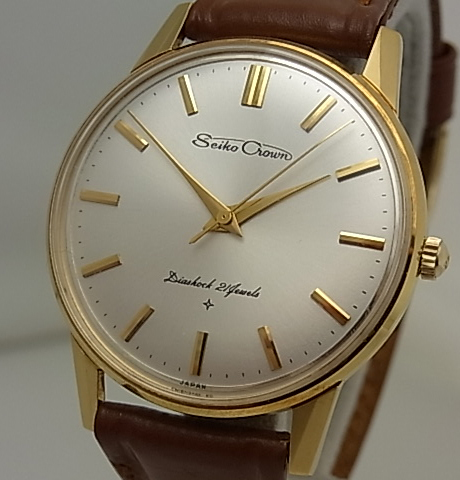
Crown 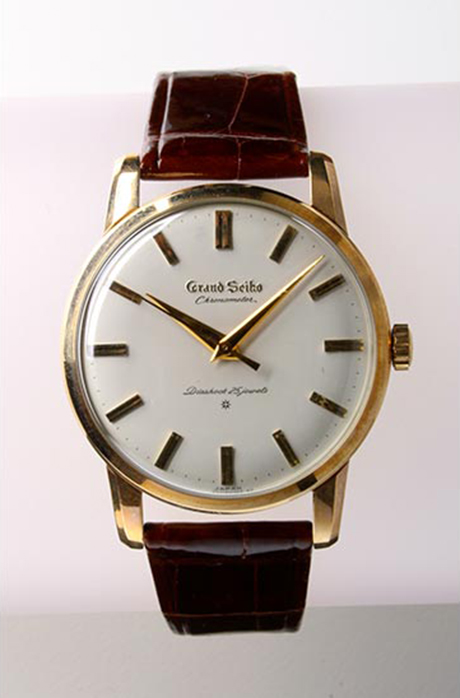
Grand Seiko, First model 1960 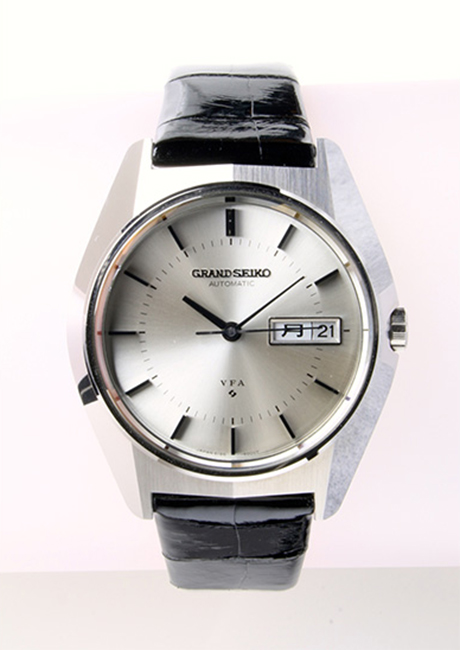
61GS V.F.A
-
STORY 04
Ascendency of Seiko's Technique as a World Standard
-
1. Date-Day Integrated Window
The history of time display started with “2 hands (hours and minutes)” and later saw convenient and practical functions such as three hands (small second hand→ center second hand) and a calendar (date→day and date).
In 1963 Seiko developed a mechanism to display the date and day in a single window. The new watch face was highly evaluated for its smart design and visibility and has since become the world standard.
2. Seiko's “Magic Lever” Self-Winding Mechanism
~Spread of the Self-Winding Mechanism~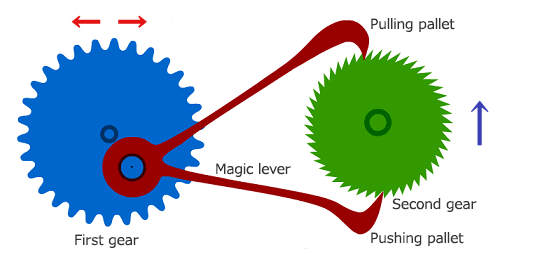
Harwood in the UK developed the first self-winding wristwatch in 1924. Rolex produced a more complete self-winding wristwatch and started mass production in 1931. Yet the Rolex was expensive for most people because of its complex mechanism and many parts.
In 1956 Seiko released the first domestic self-winding wristwatch. Then in 1959, Seiko introduced another self-winding watch, incorporating a simple “claw lever system” called the “magic lever.” The system attracted the world’s attention for its modest price and high levels of quality and performance for winding efficiency. An era of popularization for self-winding wristwatches had begun.
(By 1966, most of the exported watches from Seiko were equipped with the self-winding mechanism. Production in Japan exceeded the overall production in Switzerland.)
Wristwatches Using Quartz Technology
The Quartz clock originated from Pierre Curie's discovery of the “piezoelectric effect” in 1880 with materials capable of generating electric charges in response to applied mechanical stress. Warren A. Marrison at Bell Telephone Laboratories built an experimental machine to harness the piezoelectric effect for timekeeping in 1927. Marrison’s machine divided the frequency generated by a crystal oscillator based on the piezoelectric effect and connected it to a synchronous motor. A quartz clock Seiko produced for a broadcasting station in 1958 was as large as a locker and had to be downsized by ten-thousand times in volume and 10 million times in electricity consumption.
-
STORY 05
The Development of the Seiko Quartz Wristwatch ~Tokyo Olympics~
-
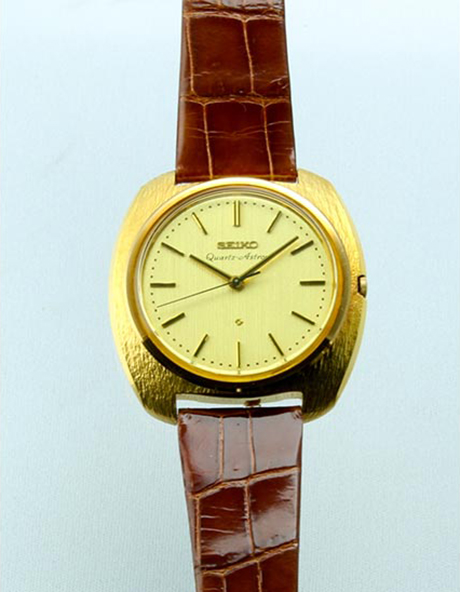
Seiko Quartz Astron The project to develop quartz wristwatches in Seiko originated from the start of the 59A project in 1959. Seiko’s decision to take charge of the official timer for the Tokyo Olympics coming up in 1964 pushed the development. Seiko completed its first portable quartz clock in 1961. Three years later, in 1964, it released an improved crystal clock (951 model) for service as the standard clock for the Tokyo Olympics. A quartz pocket watch (952 model) and a prototype wristwatch followed in 1966 and 1967, respectively. Seiko set out to commercialize the wristwatch in the late 1960s, which pushed the development still further. The Seiko Quartz Astron 35 SQ, the world’s first quartz wristwatch, was released on December 25, 1969.
-
STORY 06
Major Downsizing Technology for the Quartz Astron ~The New World Standard Method Technology~
-
Three technologies were essential for downsizing a watch to the size of a wristwatch.
1. Downsizing and Stabilization of Crystal Oscillators
~Development of a Turning Fork Crystal Oscillator~
A crystal oscillator had to generate high frequency with a compact 1.5 V battery and withstand high temperature variations, vibration, and shock. A redesign of the crystal oscillator from a bar to a turning fork enabled downsizing and stable oscillation. The oscillator was suspended in a vacuum capsule to insulate it from shock. The temperature was corrected by a thermistor-based method.
The tuning fork in the watch was the hardest component to process. The first oscillators were almost exclusively made by hand. Later, mass production became possible with the rapid development and innovation of manufacturing technology. The oscillators were then mass produced by lithography, a method to melt the periphery of the oscillator with hydrofluoric acid.
At the beginning oscillating frequency was set to 8,192Hz in consideration of various conditions, because the high frequency required for high accuracy could only be attained with abundant electricity. Later the frequency was set to 16,384Hz, and then again to the current standard of 32,768Hz, with help from newer power-saving electronic circuits. The tuning fork crystal developed by Seiko became the world standard for quartz wristwatches and was established as a time standard source for many devices using crystal oscillators.
2. Low Electricity Consumption
~Development of CMOS-IC~
The electronic circuit used to divide the frequency generated by the crystal oscillator, process it electrically, and transmit to the motor/going train consumed abundant electricity. Reducing the power consumption was a great challenge. Seiko used a hybrid IC when it released and adopted its power-saving CMOS-IC (made by another company) in the following year, but the yield was lower than ideal. Not long after Seiko replaced it with an IC developed in-house. The new IC was driven by low power in the range of 20μW. The electricity consumption of the IC in today’s wristwatches is only around 0.1μW.
3. Low Electricity Consumption and Downsized Motor
~Development of the Open Type Step Motor~
The exchange mechanism (motor) to change the electric signal to the rotation of the hands was also developed from scratch. Seiko contrived various methods, but none of the prototypes fit the target size (diameter 30 mm, thickness 5.3 mm, volume 3.74cc). Seiko then developed a step motor that rotated the motor by 60 degrees by applying one electrical pulse per a second to a coil of very thin wire (0.02 mm diameter) wound 20,000 times. The rotor and starter were arranged separately and accommodated in a newly structured mechanical body. Later, when this new "open type step motor" was further downsized and slimmed, it became the world-standard driving motor for quartz wristwatches.
-
STORY 07
The Meaning of Quartz Astron
-
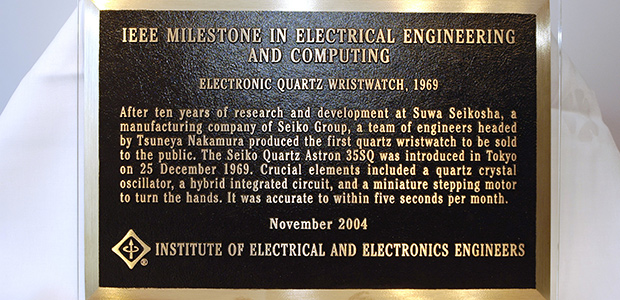
IEEE MILESTONE IN ELECTRICAL ENGINEERING AND COMPUTING The Quartz Astron is an embodiment of excellence. Seiko’s technological vision was verified when watchmakers from the world over selected Seiko methods and technologies over dozens of other options. Seiko’s open patenting policy also played a role.
In 2004, Seiko's great achievements were approved by IEEE and Seiko received the IEEE MILESTONE IN ELECTRICAL ENGINEERING AND COMPUTING.
In conclusion (Technological Trend of Wristwatches in Later Period)
All three watches designated as Mechanical Engineering Heritages helped Japan (Seiko) become a leader in the global watch industry.
The mechanical watches that dominated in the 1960s were greatly influenced by quartz watches for several years. The mechanical watches of today are developed mainly for the luxury market. Their mechanical wizardry and beauty are highly evaluated for their decorative excellence and value (complex watches such as Turbillion).
The Quartz Astron 35 SQ and ensuing quartz wristwatches revolutionized the market by rapidly improving accuracy, downsizing, slimming, and saving cost. An all-electronic digital wristwatch developed by Seiko promoted the multi-functionality of watches. Consumers today can purchase radio-controlled watches that set themselves to standard time by synchronizing with cesium beam clocks via radio signals, or wristwatches that display the time at the current place based on transmitted GPS satellite signals. Wristwatches that convert light energy and human body's movement to electrical energy and work continuously without changing batteries are also commercially available. These wristwatches generally match the accuracy of the turning fork crystal oscillator and operate using CMOS-ICs and step motors for power saving and downsizing, just as before.
Seiko named its Seiko GPS solar wristwatch released in 2012 the Astron, reviving the name after a hiatus of 40 years. Seiko hopes the new Astron will become the world standard, just as the Quartz Astron 35 SQ did in 1969.
※The Laurel, the first Grand Seiko, and the Quartz Astron were designed and manufactured by Seikosha (current Seiko clock) and Suwa Seikosha (current Seiko Epson) respectively.
Related links
Press release (to Japanese language site)
Webpage of the Japan Society of Mechanical Engineers (to Japanese language site)



